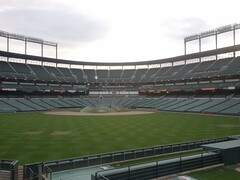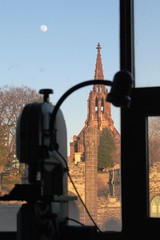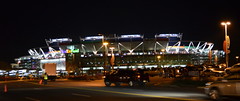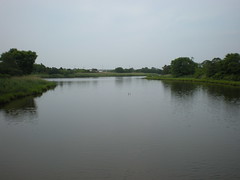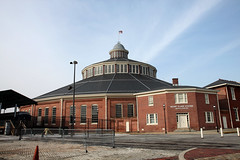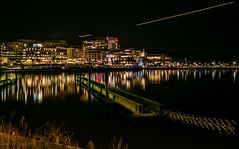Maryland
Maryland (English: /ˈmᵻlənd/) is a state in the Mid-Atlantic region of the United States. It borders Virginia, West Virginia, and Washington, D.C. to its south and west; Pennsylvania to its north; and Delaware and the Atlantic Ocean to its east. With a total land area of , Maryland is the 8th-smallest state by land area. Its population of 6,177,224 ranks it the 18th-most populous state and the 5th-most densely populated. Baltimore is the largest city in the state, and the capital is Annapolis. Among its occasional nicknames are Old Line State, the Free State, and the Chesapeake Bay State. It is named after Henrietta Maria, the French-born queen of England, Scotland, and Ireland, who was known then in England as Mary.
Before its coastline was explored by Europeans in the 16th century, Maryland was inhabited by several groups of Native Americans – mostly by Algonquian peoples and, to a lesser degree, Iroquoian and Siouan. As one of the original Thirteen Colonies of England, Maryland was founded by George Calvert, 1st Baron Baltimore, a Catholic convert who sought to provide a religious haven for Catholics persecuted in England. In 1632, Charles I of England granted Lord Baltimore a colonial charter, naming the colony after his wife, Henrietta Maria. Unlike the Pilgrims and Puritans, who rejected Catholicism in their settlements, Lord Baltimore envisioned a colony where people of different religious sects would coexist under the principle of toleration. Accordingly, in 1649 the Maryland General Assembly passed an Act Concerning Religion, which enshrined this principle by penalizing anyone who "reproached" a fellow Marylander based on religious affiliation. Nevertheless, religious strife was common in the early years, and Catholics remained a minority, albeit in greater numbers than in any other English colony.
Maryland's early settlements and population centers clustered around rivers and other waterways that empty into the Chesapeake Bay. Its economy was heavily plantation-based and centered mostly on the cultivation of tobacco. Demand for cheap labor from Maryland colonists led to the importation of numerous indentured servants and enslaved Africans. In 1760, Maryland's current boundaries took form following the settlement of a long-running border dispute with Pennsylvania. Maryland was an active participant in the events leading up to the American Revolution, and by 1776, its delegates signed the Declaration of Independence. Many of its citizens subsequently played key political and military roles in the war. In 1790, the state ceded land for the establishment of the U.S. capital of Washington, D.C.
Although then a slave state, Maryland remained in the Union during the American Civil War, its strategic location giving it a significant role in the conflict. After the Civil War, Maryland took part in the Industrial Revolution, driven by its seaports, railroad networks, and mass immigration from Europe. Since the 1940s, the state's population has grown rapidly, to approximately six million residents, and it is among the most densely populated U.S. states. , Maryland had the highest median household income of any state, owing in large part to its proximity to Washington, D.C., and a highly diversified economy spanning manufacturing, retail services, public administration, real estate, higher education, information technology, defense contracting, health care, and biotechnology. Maryland is one of the most multicultural states in the country; it is one of the six states where non-Whites compose a majority of the population, with the fifth-highest percentage of African Americans, and high numbers of residents born in Africa, Asia, Central America, and the Caribbean. The state's central role in U.S. history is reflected by its hosting of some of the highest numbers of historic landmarks per capita.
Sixteen of Maryland's twenty-three counties, as well as the city of Baltimore, border the tidal waters of the Chesapeake Bay estuary and its many tributaries, which combined total more than 4,000 miles of shoreline. Although one of the smallest states in the U.S., it features a variety of climates and topographical features that have earned it the moniker of America in Miniature. In a similar vein, Maryland's geography, culture, and history combine elements of the Mid-Atlantic, Northeastern, and Southern regions of the country.
History
17th century
Maryland's first colonial settlement
George Calvert, 1st Baron Baltimore (1579–1632), sought a charter from King Charles I for the territory between Massachusetts to the north and Virginia to the immediate south.
After Baltimore died in April 1632, the charter was granted to his son, Cecilius Calvert, 2nd Baron Baltimore (1605–1675), on June 20, 1632. Officially, the new "Maryland Colony" was named in honor of Henrietta Maria of France, wife of Charles I of England. Lord Baltimore initially proposed the name "Crescentia", the land of growth or increase, but "the King proposed Terra Mariae Land, which was concluded on and Inserted in the bill."
The original capital of Maryland was St. Mary's City, on the north shore of the Potomac River, and the county surrounding it, the first erected/created in the province, was first called Augusta Carolina, after the King, and later named St. Mary's County.
Lord Baltimore's first settlers arrived in the new colony in March 1634, with his younger brother the Honorable Leonard Calvert (1606–1647), as first provincial Governor of Maryland. They made their first permanent settlement at St. Mary's City in what is now St. Mary's County. They purchased the site from the paramount chief of the region, who was eager to establish trade. St. Mary's became the first capital of Maryland, and remained so for 60 years until 1695. More settlers soon followed. Their tobacco crops were successful and quickly made the new colony profitable. However, given the incidence of malaria, yellow fever, and typhoid, life expectancy in Maryland was about 10 years less than in New England.
Persecution of Catholics
Maryland was founded to provide a haven for England's Roman Catholic minority. Although Maryland was the most heavily Catholic of the English mainland colonies, the religion was still in the minority, consisting of less than 10% of the total population.
In 1642, a number of Puritans left Virginia for Maryland and founded Providence (now called Annapolis) on the western shore of the upper Chesapeake Bay. A dispute with traders from Virginia over Kent Island in the Chesapeake led to armed conflict. In 1644, William Claiborne, a Puritan, seized Kent Island while his associate, the pro-Parliament Puritan Richard Ingle, took over St. Mary's. Both used religion as a tool to gain popular support. The two years from 1644 to 1646 when Claiborne and his Puritan associates held sway were known as "The Plundering Time". They captured Jesuit priests, imprisoned them, then sent them back to England.
In 1646, Leonard Calvert returned with troops, recaptured St. Mary's City, and restored order. The House of Delegates passed the "Act concerning Religion" in 1649 granting religious liberty to all Trinitarian Christians.
In 1650, the Puritans revolted against the proprietary government. "Protestants swept the Catholics out of the legislature... and religious strife returned." The Puritans set up a new government prohibiting both Roman Catholicism and Anglicanism. The Puritan revolutionary government persecuted Maryland Catholics during its reign, known as the "plundering time". Mobs burned down all the original Catholic churches of southern Maryland. The Puritan rule lasted until 1658 when the Calvert family and Lord Baltimore regained proprietary control and re-enacted the Toleration Act.
After England's "Glorious Revolution" of 1688, Maryland outlawed Catholicism. In 1704, the Maryland General Assembly prohibited Catholics from operating schools, limited the corporate ownership of property to hamper religious orders from expanding or supporting themselves, and encouraged the conversion of Catholic children. The celebration of the Catholic sacraments was also officially restricted. This state of affairs lasted until after the American Revolutionary War (1775–1783). Wealthy Catholic planters built chapels on their land to practice their religion in relative secrecy.
Into the 18th century, individual priests and lay leaders claimed Maryland farms belonging to the Jesuits as personal property and bequeathed them in order to evade the legal restrictions on religious organizations' owning property.
Border disputes (1681–1760)
The royal charter granted Maryland the land north of the Potomac River up to the 40th parallel. A problem arose when Charles II granted a charter for Pennsylvania. The grant defined Pennsylvania's southern border as identical to Maryland's northern border, the 40th parallel. But the grant indicated that Charles II and William Penn assumed the 40th parallel would pass close to New Castle, Delaware when it falls north of Philadelphia, the site of which Penn had already selected for his colony's capital city. Negotiations ensued after the problem was discovered in 1681.
A compromise proposed by Charles II in 1682 was undermined by Penn's receiving the additional grant of what is now Delaware. Penn successfully argued that the Maryland charter entitled Lord Baltimore only to unsettled lands, and Dutch settlement in Delaware predated his charter. The dispute remained unresolved for nearly a century, carried on by the descendants of William Penn and Lord Baltimore—the Calvert family, which controlled Maryland, and the Penn family, which controlled Pennsylvania.
The border dispute with Pennsylvania led to Cresap's War in the 1730s. Hostilities erupted in 1730 and escalated through the first half of the decade, culminating in the deployment of military forces by Maryland in 1736 and by Pennsylvania in 1737. The armed phase of the conflict ended in May 1738 with the intervention of King Geo…
Looking for places related to Maryland?
Those are other destinations to find places related to Maryland:



